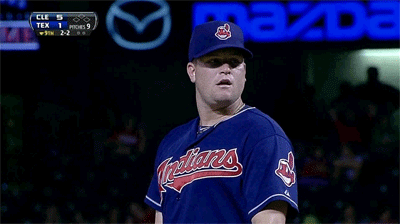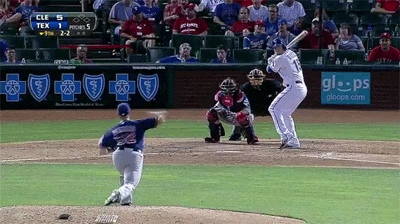Longest Plate Appearance(s) of the Week, 6/6-6/12
June 12, Indians at Rangers
Vinnie Pestano vs. Jeff Baker, 15 pitches (2013 record)
Length: 5:54
Mound visits: 0
Baker’s longest previous plate appearance: 11 pitches
Previous longest plate appearance vs. Pestano: 11 pitches
2013 League-average P/PA: 3.84
Baker P/PA: 4.022
Pestano P/PA against: 4.41
Previous match-up history: None
This week’s longest plate appearance is also the longest plate appearance of the season. It’s the longest since last August, when Scott Rolen went 15 pitches against Wade Miley. Neither of the players involved is a household name—even if you have a really large household—but both produce an above-average number of pitches per plate appearance, which makes a 15-pitch plate appearance between them (slightly) less unlikely. Still extremely unlikely! Just slightly less so.
Baker has become more selective this season—in addition to starting at six positions and nearing his career-high in homers in under 100 plate appearances—and Pestano has become much less efficient since his first full season, when he threw a couple miles per hour harder and missed more bats. Among pitchers who’ve thrown at least 15 innings this season, only four—Michael Kohn, Tyler Clippard, Kevin Gregg, and Jake McGee—have thrown more pitches per plate appearance than Pestano.
One note: although this is the longest plate appearance of the season in terms of pitches thrown, it’s not the longest in terms of time elapsed. The Kevin Slowey-Paul Goldschmidt PA we looked at a few weeks ago lasted longer, and that one went only 13 pitches; the 14-pitch battle between Jose Fernandez and Matt Joyce last week lasted 7:35 (from Fernandez’s first motion to when Joyce’s single fell in). Pestano worked quickly, and Baker doesn’t have any time-consuming pre-pitch rituals.
The plot (catcher’s perspective):
To Pestano’s credit, he wasn’t wild. Almost all of his pitches were close enough to the strike zone that Baker had to think about swinging, and only twice did Baker let a ball go by.
Pestano’s pitch usage is pretty predictable: he’s going to throw some sort of fastball in the low 90s almost 80 percent of the time, relying heavily on four-seamers and mixing in the occasional sinker. The remaining 20 or so percent of the time, he’ll throw his breaking ball, which MLBAM calls a slider and Brooks Baseball labels a slider. So this is what the velocity chart looks like when Pestano throws 15 pitches:
The exhausted player(s):
Pestano heaves a heavy sigh.

Baker wipes away some sweat.

And on-deck batter Chris McGuiness gets exhausted from standing. Batting helmets are hot, and Texas is hotter. (The gametime temperature was 93 degrees.)

The sequence:
1. 0-0: 90-mph four-seamer, called strike

Baker has swung at only 22.8 percent of first pitches this season, so Pestano takes the opportunity to get ahead in the count. Don’t get too used to the sight of Baker not swinging.
2. 0-1: 91-mph four-seamer, swinging strike

Pestano elevates slightly, and Baker goes after it. This is the only pitch Baker will swing through in the at-bat.
3. 0-2: 91-mph four-seamer, foul

Having convinced Baker to swing at a four-seamer above the zone on his second pitch, Pestano goes a little higher up the ladder—catcher Carlos Santana is literally standing to emphasize how high he wants this one. Pestano is rewarded with another swing, and weak contact.
This is the first of three times that the at-bat almost ended much earlier than it actually did. Had Baker swung a millisecond earlier, or had the ball taken a different hop, this would’ve been a fair ball and an easy out at first base. The recipe for an epic plate appearance calls for a lot of ingredients dispensed in precise portions; it’s not enough to put a pesky batter and an inefficient pitcher together. Many things have to happen in a certain sequence for plate appearances to last as long as this one did, and the forces of probability are always conspiring to end them early.
Case in point: in his first three at-bats of the game against Ubaldo Jimenez, who’s on the inefficient side himself, Baker struck out on three pitches, popped out on two pitches, and grounded out on three pitches. And immediately after throwing 15 pitches to Baker, Pestano struck out McGuiness on three pitches.
4. 0-2: 90-mph four-seamer, ball

Pestano’s gameplan is obvious: throw the ball higher and higher until Baker stops swinging. This time the four-seamer is a little too high for Baker’s taste, and he lets it go for ball one.
There’s a reason Pestano is trying to get Baker out up in the zone. Here’s Baker’s swing rate by location in the PITCHf/x era:
See those red squares at the top of the strike zone and above? Baker has a tough time laying off those pitches. So what happens when he goes after them? Here’s Baker’s TAv by location, also from 2007-present:
Those boxes that were red before are blue now. Baker likes to swing at high pitches, but he doesn’t hit them that hard.
5. 1-2: 91-mph four-seamer, ball

Another four-seamer, but off the edge of the zone this time. This was a ball, but Santana makes it look farther away than it was, sweeping his glove across the zone and letting it push the pitch away from the plate. With two strikes, this would’ve been a tough strike call to get with anyone behind the plate, but a better receiver would have given Pestano a better chance.
6. 2-2: 91-mph four-seamer, foul

This is a pretty hittable pitch. It’s the same speed as the previous one in the same vicinity, but gets part of the plate. Baker is late anyway.
7. 2-2: 92-mph two-seamer, foul

A two-seamer in almost exactly the same location as pitch no. 5. Baker, in full protect mode, throws the bat at the ball and manages to make contact. This is the second time that the at-bat almost ended early with a weak groundball.
8. 2-2: 80-mph slider, foul

Pestano finally shows Baker his breaking ball, but it’s a bad one, a hanger almost perfectly centered over the plate. This was probably the most hittable pitch of the plate appearance. The height of the pop-up suggests that Baker might not have missed it by much, but he narrowly escapes an out for the third time, as Swisher can’t get his glove on the ball a couple rows into the Rangers fan-filled crowd. Jeter woulda had it.
We’re more than halfway through!
9. 2-2: 91-mph four-seamer, foul

Another hittable pitch Baker could have crushed. Having just had his bat slowed down by the slider, he was a little late. Pitchers make mistakes, and often hitters miss them.
10. 2-2: 91-mph four-seamer, foul

Pestano aims up in the zone again—Baker’s guilty pleasure—but he doesn’t have the velo to blow it by him.
11. 2-2: 92-mph four-seamer, foul

Same eye level, but over the plate. Baker gets a better piece of it, fouling it almost straight back.
12. 2-2: 90-mph four-seamer, foul

Almost certainly ball three, especially with Santana catching, but Baker’s brain is set to swing. He barely touches this one; both he and Santana were surprised to see that it didn’t end up in the glove.
13. 2-2: 91-mph four-seamer, foul

Pestano has thrown almost everything up or away. Baker has essentially been able to eliminate the inside part of the plate and the possibility of anything but a 90-92 mph fastball, but he hasn’t been able to time Pestano’s pitches.
At this point, the Rangers’ broadcasters have started to sound punch drunk, giggling after every offering that extends the at-bat. “What’s the record? I don’t know,” one of them says. (In the 1988-present era for which we have the data necessary to determine the answer, it’s 20 pitches.)
14. 91-mph four-seamer, foul

Finally an inside pitch, and another foul off the other way. To watch this at-bat, you’d think Baker hits everything the other way, but his batted balls this season have been fairly evenly distributed around the field:

Something to keep in mind in all plate appearances of this sort: Russell Carleton’s research into foul balls found that hitters have a better chance of getting on base if they’ve fouled off several pitches after being down in the count, even if the count hasn’t changed.
15. 91-mph four-seamer, in play

Fifteen pitches, and we never reached a three-ball count. Fittingly, the longest plate appearance of the season (so far) ends on another outside fastball and another weak grounder that (this time) stays fair. Pestano gets the end of his glove on the ball, deflecting it slightly, and Baker nearly beats it out. Ron Washington comes out to argue, but he doesn’t get anywhere; even on replay, it’s tough to tell whether Baker arrived at first base before the ball.
In one sense, it’s an anticlimactic ending—a plate appearance that long seems like it should have a more dramatic outcome. But in another sense, it’s the most appropriate ending possible. Baker was out, but he could’ve easily been safe, just as he wasn’t out, but easily could’ve been, a few times earlier in the at-bat. All long plate appearances are inches away from unremarkable.
Thank you for reading
This is a free article. If you enjoyed it, consider subscribing to Baseball Prospectus. Subscriptions support ongoing public baseball research and analysis in an increasingly proprietary environment.
Subscribe now